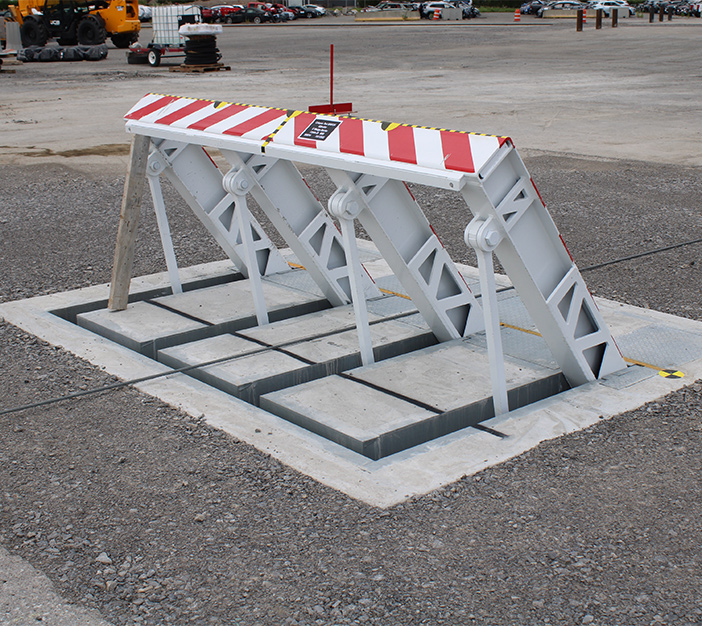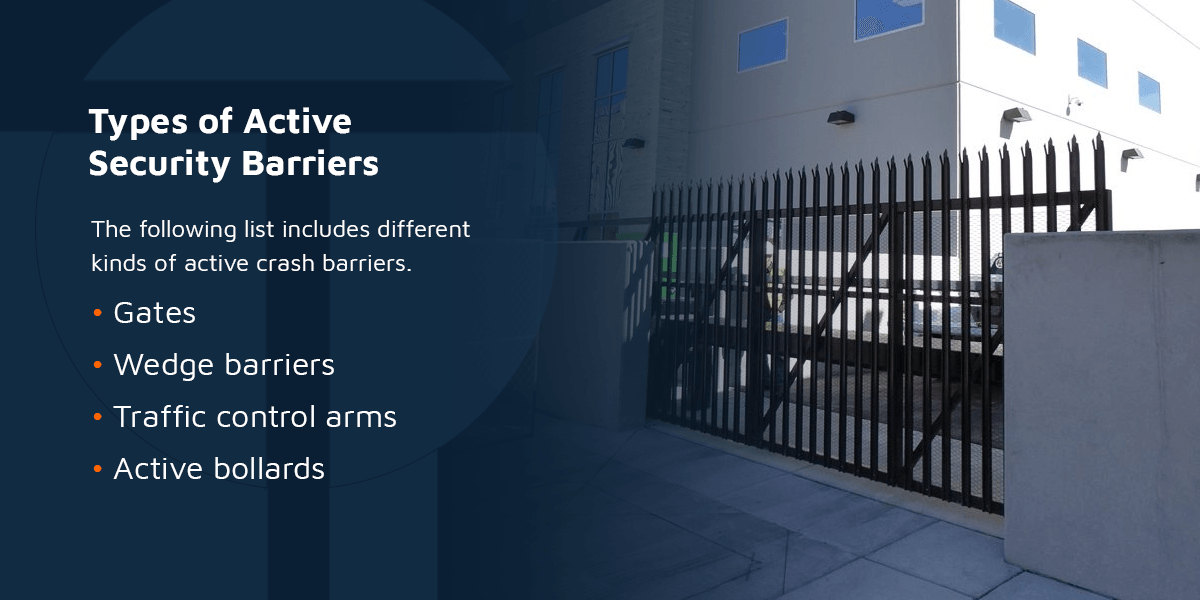Some Of Wedge Barriers
Table of ContentsThe Best Guide To Wedge BarriersWedge Barriers Can Be Fun For Anyone

14 and the surface 12 to which the barrier 10 is protected might be made from concrete - Wedge Barriers. 2, the barrier 10 is placed to or consists of a support or subframe (e. g., support 30 received FIG. 2 )protected underneath the surface 12. As an example, the bather 10 may be bolted to the support or safeguarded to the support by various other mechanical bolts. In the illustrated embodiment, the obstacle 10 includes a wedge plate 16, which includes a section that is significantly identical with the surface area 12 when the barrier 10 remains in the retracted placement. To put it simply, lorries or individuals may overlook the obstacle 10 when the barrier 10 remains in the pulled back setting and experience slight elevation family member to the surface 12 while on the obstacle 10. As reviewed in detail listed below, when the barrier 10 remains in the released setting, the wedge plate 16 is held and sustained in a raised setting by a training system of the barrier 10. In addition, the components 18 might be bolted or otherwise mechanically coupled to each other. In this way, repair service or replacement of several parts 18 may be simplified and structured. That is, fixing or replacement of single components
18 may be done extra swiftly, conveniently, and price successfully. FIG. In particular embodiments, the anchor 30 might be a steel structure including plates, beam of lights(e. g., I-beams ), and/or other structures that are protected within the structure 14, which may be concrete. At the surface 12, an upper side 28 of the support 30 might go to the very least partly subjected
, thereby allowing the add-on of the barrier 10 to the anchor 30. g., threaded holes)in one or more beam of lights or plates of the support 30 might be revealed to the surface area 12. In this fashion, bolts 32 or various other mechanical fasteners may be utilized to safeguard the obstacle 10 to the anchor 30. As the obstacle 10 is mounted to the surface 12 of the structure 14, collection of debris and various other product below the barrier might be decreased, and elements of the bather 10 might not be subjected to listed below grade environments. As shown by reference character 52, the training mechanism 50 consists of components disposed underneath the wedge plate 16. As an example, the parts 52 below the wedge plate 16 may include an electromechanical actuator, a web cam, several cam surface areas, etc. In addition, the training system 50 consists of a springtime setting up 54
The spring rod 58 is coupled to a webcam(e. g., webcam 80 displayed in FIG. 4) of the lifting mechanism 50. The springtimes 60 disposed about the spring pole 58 are kept in compression by spring supports 62, consisting of a repaired springtime assistance 64. That is, the set springtime assistance 64 is fixed loved one to the structure 14 and the remainder of the bather 10.
An Unbiased View of Wedge Barriers
The remaining pressure applied to
the cam camera deploy release wedge plate 16 may be provided by an electromechanical actuator 84 or other various other. The springtime setting up 54 and the actuator 84(e. Wedge Barriers. g., electromechanical actuator)might run with each other to convert the web cam and raise the wedge plate 16.
As discussed above, the springtime setting up check my reference 54 exerts a constant pressure on the web cam, while the electromechanical actuator may be managed to put in a variable pressure on the web cam, therefore making it possible for the training and decreasing( i. e., releasing and pulling back )of the wedge plate 16. In specific embodiments, the continuous force applied by the spring assembly 54 might be flexible. g., electromechanical actuator) is handicapped. As will be valued, the spring setting up 54 may be covered and protected from particles or other components by a cover plate(e. g., cover plate 68 displayed in FIG. 4) that may be substantially flush with the elevated surface 38 of the structure 14. As pointed out above, in the deployed placement, the wedge plate 16 offers to block accessibility or traveling beyond the barrier 10. For instance, the barrier 10(e. g., the wedge plate 16 )may obstruct pedestrians or cars from accessing a property or pathway. As gone over over, the barrier 10 is affixed to the anchor 30 safeguarded within the structure 14,

front braces 71. Because of this, the affiliation assemblies 72 may pivot and rotate to make it possible for the collapse and extension of the linkage assemblies 72 throughout retraction and deployment of the bather 10. The affiliation assemblies 72 cause motion of the wedge plate 16 to be restricted. If an automobile is traveling towards the released wedge plate 16(e. For example, in one circumstance, the safety and security legs 86 may article be expanded throughoutmaintenance of the barrier 10. When the safety and security legs 86 are deployed, the safety and security legs 86 sustain the weight of the wedge plate 16 against the surface 12. Consequently, the training system 50 may be shut down, serviced, gotten rid of, changed, and so forth. FIG. 5 is partial viewpoint sight of an embodiment of the surface-mounted wedge-style obstacle 10, showing the cam 80 and the webcam surface areas 82 of the lifting mechanism 50. Particularly, two cam surface areas 82, which are described as reduced camera surface areas 83, are positioned below the camera 80. The reduced web cam surfaces 83 might be repaired to the surface area 12 (e. As an example, the reduced camera surface areas 83 and the mounting plate 85 Get More Info might create a solitary piece that is protected to the anchor 30 by bolts or various other mechanical fasteners. In addition, 2 web cam surface areas 82, which are described as upper web cam surfaces 87, are placed over the webcam 80 and paired to (e. In other personifications, stepping in layers or plates might be positioned in between the surface area 12 and the lower camera surfaces 83 and/or the wedge plate 16 and the upper camera surface areas 87 As discussed over, the cam
80 equates along the cam surfaces 82 when the wedge plate 16 is raised from the pulled back position to the deployed placement. Furthermore, as mentioned over, the spring setting up 54 (see FIG. 3 )might supply a force acting upon the webcam 80 in the instructions 102 by means of spring rod 58, which might decrease the force the electromechanical actuator 84 is required to put on the camera 80 in order to actuate and lift the wedge plate 16. 1 )to the released position(see FIG. 4). As revealed, the camera 80 consists of track wheels 104(e. g., rollers), which call and translate along the camera surface areas 82 throughout procedure.